|
|
Ethernet Interface Processor (EIP) Installation and Configuration
Product Numbers: CX--EIP2, CX-EIP4, and CX--EIP6
This publication provides instructions for installing the Ethernet interface processor (EIP) in your Cisco 7000 series and Cisco 7500 series router. The upgrade instructions include steps for upgrading the EIP microcode by downloading a new image. This publication also contains basic configuration steps and examples for configuring the Ethernet interfaces on a new EIP.
For complete descriptions of interface subcommands and the configuration options available for Ethernet interfaces, refer to the Router Products Command Reference and Router Products Command Summary publications, available on Cisco Connection Documentation CD-ROM or in print.
Sections in this publication include the following:
This section provides a description of Ethernet theory and of the EIP features and functions.
The term Ethernet is commonly used for all carrier sense multiple access/collision detection (CSMA/CD) local area networks (LANs) that generally conform to Ethernet specifications, including IEEE 802.3. Ethernet Version 2 and IEEE 802.3 were based on, and developed shortly after, Ethernet Version 1. The slight differences between Ethernet and IEEE 802.3 are implemented in hardware, and both are supported automatically by the EIP without any hardware or software configuration changes. Together, Ethernet and IEEE 802.3 are the most widely used local-area network protocols. They are well suited to applications where a local communication medium must carry sporadic, occasionally heavy traffic at high peak data rates.
Stations on a CSMA/CD LAN can access the network at any time. Before sending data, the station listens to the network to see of it is already in use. If it is, the station waits until the network is not in use, then transmits. A collision occurs when two stations listen for network traffic, hear none, and transmit simultaneously. When this happens, both transmissions are damaged, and the stations must retransmit them. The stations detect the collision and use backoff algorithms to determine when they should retransmit.
Both Ethernet and IEEE 802.3, are broadcast networks, which means that all stations see all transmissions. Each station must examine received frames to determine whether it is the intended destination and, if it is, pass the frame to a higher protocol layer for processing. IEEE 802.3 specifies several different physical layers, and Ethernet defines only one. Each IEEE 802.3 physical layer protocol has a name that summarizes it characteristics in the format speed/signaling method/segment length where speed is the LAN speed in Mbps, signaling method is the signaling method used (either Baseband or Broadband), and segment length is the maximum length between stations in hundreds of meters. For example, 10Base5 specifies a 10Mbps Baseband LAN with network segments spaced at 500 meters. Table 1 summarizes the characteristics of Ethernet Version 2 and IEEE 802.3.
Table 1 Ethernet Version 2 and IEEE 802.3 Physical Characteristics
| Ethernet | IEEE 802.3 | |||
|---|---|---|---|---|
| 10Base5 | 10Base2 | 10BaseT | ||
| Data Rate (Mbps) | 10 | 10 | 10 | 10 |
| Signaling method | Baseband | Baseband | Baseband | Baseband |
| Max. segment length (m) | 500 | 500 | 185 | 100 (UTP) |
| Media | 50-ohm coax (thick) | 50-ohm coax (thick) | 50-ohm coax (thin) | Unshielded twisted pair (UTP) |
| Topology | Bus | Bus | Bus | Star |
Ethernet is most similar to IEEE 802.3 10Base5. Both of these protocols specify a bus topology network with a connecting cable between the end stations and the actual network medium. Both protocols require a device that acts as an interface between the end stations in this case, the EIP) and the actual network medium (cable). The Ethernet specifications call this device a transceiver and it is connected to the station with a transceiver cable. The IEEE 802.3 specifications refers to the same type of device as a media attachment unit (MAU) and to the cable as an attachment unit interface (AUI). Both transceiver cables and AUIs can connect to the EIP ports directly.
The Ethernet interface processor (EIP) provides two, four, or six high-speed AUI (10 Mbps) ports; Figure 1 shows a six-port EIP. Each port supports both Ethernet Version 1 and IEEE 802.3/Ethernet Version 2 interfaces. A 16-million-instructions-per-second (mips) bit-slice processor provides a high-speed data path between the EIP and other interface processors. The EIP firmware (microcode), which contains card-specific software instructions, resides in a ROM in socket U101.
Figure 1 Ethernet Interface Processor (EIP)
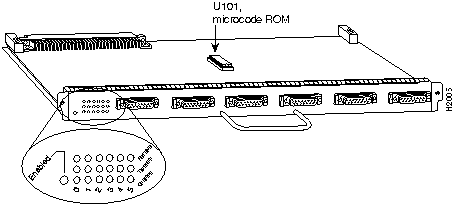
You can install interface processors in all available interface processor slots. (Refer to Figure 6, Figure 7, Figure 8, Figure 9, or Figure 10, depending on your chassis type.) Each Ethernet port requires an Ethernet transceiver or a media attachment unit (MAU) and a transceiver cable or attachment unit interface (AUI) to connect to the external network.
The two, four, or six Ethernet connectors on the EIP are standard 15-pin female AUI connectors. Each port supports both Ethernet Version 1 and IEEE 802.3/Ethernet Version 2 interfaces; the EIP senses the type of connection from the interface cable you connect and adjusts automatically for the appropriate interface type. The ports are independent, so you can mix both versions on one EIP. Slide-type cable locks are standard on all ports; however, an adapter kit is included with each EIP so that you can change the locks to the jackscrew type to accommodate your interface cables. Refer to the section "Ethernet Connector Locks" on page 6 for a description.
Table 2 lists the signals for the 15-pin Ethernet connector used on the EIP ports.
Table 2 Ethernet Connector Signals
| Pin | Circuit | Description |
|---|---|---|
| 3 | DO-A | Data Out Circuit A |
| 10 | DO-B | Data Out Circuit B |
| 11 | DO-S | Data Out Circuit Shield |
| 5 | DI-A | Data In Circuit A |
| 12 | DI-B | Data In Circuit B |
| 4 | DI-S | Data In Circuit Shield |
| 7 | CO-A | Control Out Circuit A (not used) |
| 15 | CO-B | Control Out Circuit B (not used) |
| 8 | CO-S | Control Out Circuit Shield (not used) |
| 2 | CI-A | Control In Circuit A |
| 9 | CI-B | Control In Circuit B |
| 1 | CI-S | Control In Circuit Shield |
| 6 | VC | Voltage Common |
| 13 | VP | Voltage Plus |
| 14 | VS | Voltage Shield |
| Shell | PG | Protective Ground/Case Ground |
The EIP contains the enabled LED that is standard on all interface processors and a bank of status LEDs for each of the ports. After system initialization, the enabled LED goes on to indicate that the EIP has been enabled for operation. The following conditions must be met before the EIP is enabled:
If any of these conditions is not met, or if the initialization fails for other reasons, the enabled LED does not go on.
Below the enabled LED, a bank of LEDs indicate the state of each physical port. The upper row of three LEDs indicates the state of port 0, the row below the first indicates port 1, and so on. Each row of LEDs indicates that the corresponding port is in one of the of three possible states:
These LED states are described in more detail the section "Checking the Installation" on page 22.
The EIP microcode (firmware) is a software image that provides card-specific software instructions. A ROM component in socket U101 of the EIP module card contains the default EIP microcode. The router supports downloadable microcode, which enables you to upgrade microcode versions by downloading new microcode images, storing them in Flash memory, and instructing the system to load an image from Flash instead of the default ROM image. You can store multiple images for an interface type and, with a configuration command, instruct the system to load any one of them or the default ROM image. All interfaces of the same type (EIP, HIP, and so on) will load the same microcode image, either from the default ROM image or from a single image stored in Flash.
Although multiple microcode versions for a specific interface type can be stored concurrently in Flash, only one image can load at startup. The show controller cxbus command displays the currently loaded and running microcode version for each interface processor. The show configuration EXEC command shows the current system instructions for loading microcode at startup.
For a complete description of microcode and downloading procedures, refer to the section "Upgrading Microcode" on page 31.
The Ethernet ports on the EIP are standard 15-pin female AUI connectors that require an AUI or transceiver cable with a 15-pin male connector. (See Figure 2.)
Figure 2 Ethernet AUI Plug and Receptacle
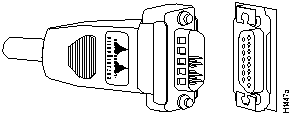
You will need an Ethernet transceiver to provide the interface between the EIP ports and the Ethernet network. Most connections require a transceiver cable between the transceiver and the EIP. (See Figure 3.) However, some unshielded twisted-pair (10BaseT) transceivers are compact enough to connect directly to the EIP ports without impeding other connections. When planning your installation and connections, be sure to consider the high density of ports on the EIP, its proximity to other interface processors, and the size of any transceivers you plan to connect directly to the ports. If possible, install the EIP in an interface processor slot between two unoccupied slots to prevent the transceivers from overlapping the ports on adjacent interface processors.
Figure 3 shows an example of a typical Ethernet AUI connection.
Figure 3 Ethernet Cable Connection

Ethernet ports use either slide-type locks (as shown in Figure 4) or screw-type locks (shown in Figure 5) to secure the cable to the port and provide strain relief. The slide-type lock is most common and is used on the EIP ports. The type of connector lock you use on the EIP depends on the type of Ethernet interface cables you use. Cables with two short posts on the cable connector need the slide-type lock shown in Figure 4; a bracket on the port slides (or snaps) around the posts on the cable connector to secure it.
Figure 4 Ethernet Connector Slide Lock
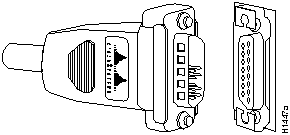
The slide-type locks are standard on the EIP ports; however, conversion kits are included with each EIP to replace the slide-type locks on ports you will connect to interface equipment that uses the screw-type locks. Cables with knurled thumbscrews (screws you can tighten with your fingers) on the cable connector need a port with jackscrews into which you insert and tighten the thumbscrews. (See Figure 5.)
Figure 5 Ethernet Connector Jackscrews
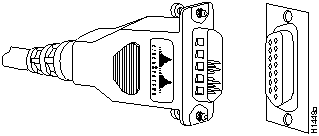
Network interfaces for a Cisco 7000 series reside on modular interface processors, which provide a direct connection between the high-speed Cisco Extended Bus (CxBus) and the external networks.
Figure 6 and Figure 7 show the rear of the Cisco 7000 series router: the seven-slot Cisco 7000 and the five-slot Cisco 7010. Access to the processor slots and the removable power supplies is from the rear, as shown. Two slots are reserved for the Route Processor (RP), which contains the system processor, and the Switch Processor (SP) (or Silicon Switch Processor [SSP]), which performs packet switching functions. The remaining slots support any combination of network interface types: serial, Ethernet, Token Ring, FDDI, or HSSI.
The EIP and all other interface processors support online insertion and removal (OIR), which allows you to remove and install an EIP while the system is operating, without shutting down system power.
Figure 6 Cisco 7000, Interface Processor End
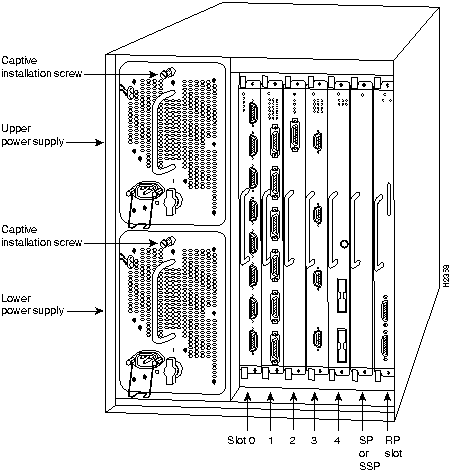
Figure 7 Cisco 7010, Interface Processor End
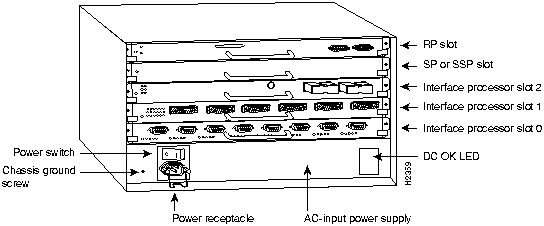
The Cisco 7500 series consists of three router models: the Cisco 7505, the Cisco 7507, and the Cisco 7513. All three models provide high reliability, availability, serviceability, and performance. The three systems support multiprotocol, multimedia routing, and bridging with a wide variety of protocols and any combination of Ethernet, Fast Ethernet, Token Ring, Fiber Distributed Data Interface (FDDI), serial, multichannel, channel attachment, and High-Speed Serial Interface (HSSI) media. Network interfaces reside on modular interface processors, which provide a direct connection between the high-speed, 1.067-gigabits-per-second (Gbps) Cisco Extended Bus (CyBus) and the external networks.
Figure 8 shows the rear of the five-slot Cisco 7505 router. In the Cisco 7505, one slot (4) is reserved for the Route Switch Processor (RSP1), which contains the system processor and performs packet switching functions. Slots 0 through 3 are for interface processors.
Figure 8 Cisco 7505, Interface Processor End

Figure 9 shows the rear of the seven-slot Cisco 7507 router. In the Cisco 7507, up to two slots (2 and 3) are reserved for the Route Switch Processor (RSP2), which contains the system processor and performs packet switching functions. Slots 0 and 1, and 4 through 6 are for interface processors.
Figure 9 Cisco 7507, Interface Processor End
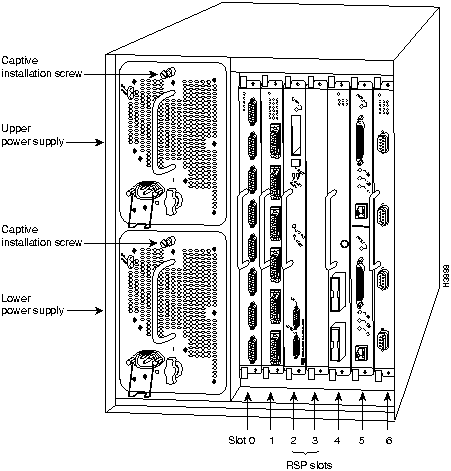
Figure 10 shows the rear of the Cisco 7513, with two AC-input power supplies installed. Two slots (6 and 7) are reserved for the second generation Route Switch Processor (RSP2), which contains the system processor and performs packet switching functions. Slots 0 through 5, and 8 through 12 are for interface processors.
Figure 10 Cisco 7513, Interface Processor End
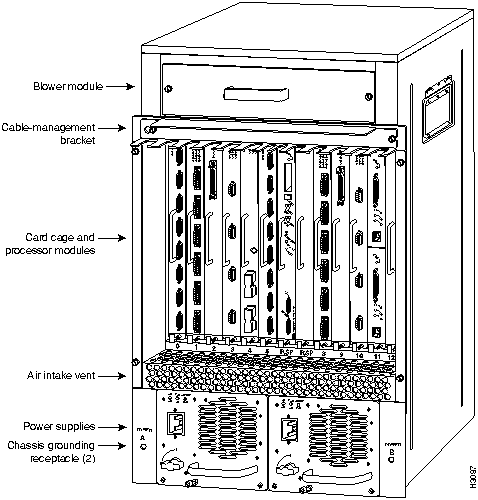
This section provides a list of parts and tools you will need to perform the installation, and safety and ESD-prevention guidelines to help you to avoid injury and damage to the equipment. It also provides a detailed description of the online insertion and removal (OIR) function to help you perform online installation successfully and avoid error message and system restarts. If you are installing a new EIP, be sure to review the equipment descriptions and distance limitations in the section "Ethernet Network Connections" on page 5 when preparing your site and planning network connections.
The maximum distances for Ethernet network segments and connections depend on the type of transmission cable used: 0.4 diameter coax (10Base5), 0.25-inch diameter coax (10Base2), or unshielded twisted-pair (10BaseT). The term 10Base5 is an abbreviation for 10-Mbps transmission, Baseband medium, and a maximum cable length of 500 meters.
Network connections to the coax-type cables are tapped into a network segment and must be spaced at specific intervals. The maximum number of connections (taps) per segment and the recommended intervals at which they must be placed are shown in Table 3. A maximum of four repeaters can be used to link segments in a single network.
Table 3 Ethernet Coax-Type Connection Limits for 10-Mbps Transmission
| Parameter | 10Base5 | 10Base2 |
|---|---|---|
| Cable diameter | 1 cm (0.4 in) | 0.6 cm (0.25 in) |
| Maximum segment length | 1640 ft (500 m) | 500 ft (152 m) |
| Maximum network length (with 4 repeaters) | 8200 ft (2500 m) | 2500 ft (762 m) |
| Maximum connections (taps per segment) | 100 | 30 |
| Minimum connection (tap) spacing | 8.2 ft (2.5 m) | 1.64 ft (0.5 m) |
The unshielded twisted-pair (UTP) cabling used with 10BaseT is suitable for voice transmission, but might incur problems transmitting data at 10-Mbps rates. The IEEE recommendations for the maximum distance between station (connection) and hub is 328 feet (100 meters) for 10BaseT at 10 Mbps.
![]()
You need an Ethernet transceiver or media attachment unit (MAU) to connect the EIP port to the Ethernet network. Several types of single-port and multiport transceivers are available. The type you use depends on the type of cabling your Ethernet network uses: thick wire (10Base5), thin wire (10Base2), or unshielded twisted pair (10BaseT at 10 Mbps). Some examples are shown in Figure 11. You can connect either Ethernet Version 1 or Version 2/IEEE 802.3 interfaces; the EIP automatically supports both types.
Figure 11 Examples of Ethernet Transceiver Connections

Following are safety guidelines that you should follow when working with any equipment that connects to electrical power or telephone wiring.
Follow these basic guidelines when working with any electrical equipment:
Use the following guidelines when working with any equipment that is connected to telephone wiring or to other network cabling:
Electrostatic discharge (ESD) damage, which can occur when electronic cards or components are improperly handled, results in complete or intermittent failures. The EIP comprises a printed circuit board that is fixed in a metal carrier. Electromagnetic interference (EMI) shielding, connectors, and a handle are integral components of the carrier. Although the metal carrier helps to protect the board from ESD, use a preventive antistatic strap whenever handling the EIP. Handle the carriers by the handles and the carrier edges only; never touch the boards or connector pins. Following are guidelines for preventing ESD damage:
![]()
Online insertion and removal (OIR) allows you to remove and replace interface processors while the system is operating; you do not need to notify the software or shut down the system power. This section describes the mechanical functions of the system components and stresses the importance of following the correct procedures to avoid unnecessary restarts or card failures. This section is for background information only. Subsequent sections provide specific procedures for removing and installing an EIP. All CxBus and CyBus interface processors support OIR
Each processor module contains a bus connector with which it connects to the system backplane. The bus connector is a set of tiered pins, in three lengths. The pins send specific signals to the system as they make contact with the backplane. The system assesses the signals it receives and the order in which it receives them to determine what event is occurring and what task it needs to perform, such as reinitializing new interfaces or shutting down removed ones. For example, when you insert an interface processor, the longest pins make contact with the backplane first, and the shortest pins make contact last. The system recognizes the signals and the sequence in which it receives them. The system expects to receive signals from the individual pins in this logical sequence, and the ejector levers help to ensure that the pins mate in this sequence.
When you remove or insert an interface processor, the backplane pins send signals to notify the system, which then performs as follows:
OIR functionality enables you to add, remove, or replace interface processors with the system online, which provides a method that is seamless to end users on the network, maintains all routing information, and ensures session preservation.
When you insert a new interface processor, the system runs a diagnostic test on the new interfaces and compares them to the existing configuration. If this initial diagnostic test fails, the system remains off line for another 15 seconds while it performs a second set of diagnostic tests to determine whether or not the interface processor is faulty and if normal system operation is possible.
If the second diagnostic test passes, which indicates that the system is operating normally and the new interface processor is faulty, the system resumes normal operation but leaves the new interfaces disabled. If the second diagnostic test fails, the system crashes, which usually indicates that the new interface processor has created a problem on the bus and should be removed.
The system brings online only interfaces that match the current configuration and were previously configured as up; all other interfaces require that you configure them with the configure command. On interface processors with multiple interfaces, only the interfaces that have already been configured are brought online. The new interface remains in the administratively shutdown state until you configure it and bring it online.
![]()
The function of the ejector levers (see Figure 12) is to align and seat the card connectors in the backplane. Failure to use the ejectors and insert the interface processor properly can disrupt the order in which the pins make contact with the backplane.
Follow the EIP installation and removal instructions carefully, and review the following examples of incorrect insertion practices and results:
It is also important to use the ejector levers when removing an interface processor to ensure that the board connector pins disconnect from the backplane in the logical sequence expected by the system. Any processor module that is only partially connected to the backplane can hang the bus.
Figure 12 Ejector Levers and Captive Installation Screws
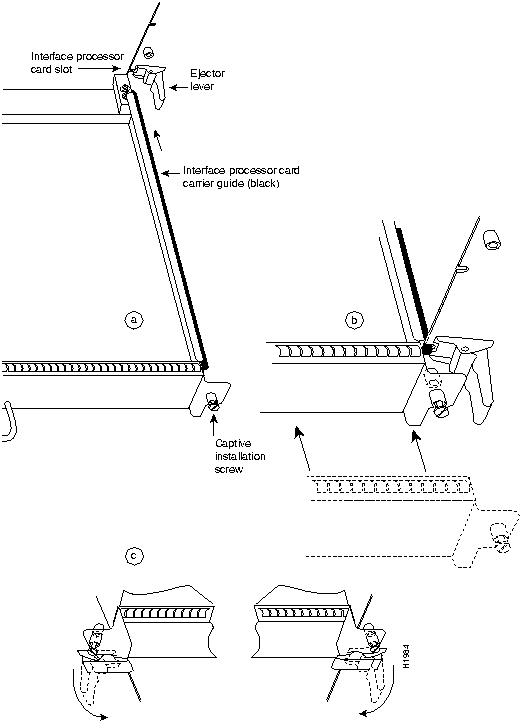
You need the following tools and parts to install or upgrade an EIP. If you need additional equipment, contact a customer service representative for ordering information.
The following sections describe the procedures for removing or installing an EIP in the Cisco 7000. The OIR function allows you to install and remove an EIP without first shutting down the system; however, you must follow the instructions carefully. Failure to insert the EIP properly can cause system error messages indicating a board failure. For a complete description of OIR, refer to the section "Online Insertion and Removal---An Overview" on page 16.
Each unused interface processor slot contains an interface processor filler (which is an interface processor carrier without an interface board) to keep dust out of the chassis and to maintain proper air flow through the interface processor compartment. If you are installing a new EIP that is not a replacement, you must first remove the interface processor filler from an unused slot; proceed to the section "Removing an Interface Processor Filler" on page 19. If you are replacing an EIP or upgrading the microcode EPROM on an EIP, proceed to the section "Removing an EIP" on page 20.
Select an unused interface processor slot for the new EIP and remove the interface processor filler as follows:
To help prevent dust and contaminants from entering the chassis, do not leave the interface processor slot open. Immediately proceed to the section "Installing an EIP" on page 21.
The EIP supports OIR; therefore, you need not shut down the interface or the system power when removing an EIP. If you are replacing a failed EIP, remove the existing board first, then replace the new EIP in the same slot. Figure 13 shows proper handling of an interface processor during installation.
Figure 13 shows proper handling of an interface processor for installation in the Cisco 7010 and Cisco 7505 models. The processor slots are oriented horizontally in the Cisco 7010 and Cisco 7505, and vertically in the Cisco 7000, Cisco 7507, and Cisco 7513.
To remove an EIP, follow these steps:
![]()
Figure 13 Handling an Interface Processor During Installation and Removal
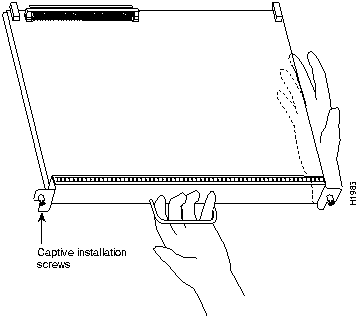
To help prevent dust and contaminants from entering the chassis, do not leave the interface processor slot open. Immediately proceed to "Installing an EIP."
The EIP slides into the open interface processor slot and directly to the backplane. The interface processors are keyed to guide pins on the backplane, so the EIP can be installed only in an interface processor slot. (Refer to Figure 6, Figure 7, Figure 8, Figure 9, or Figure 10, depending on your chassis type.) Figure 12 shows the functional details of inserting an interface processor and using the ejectors. Figure 13 shows proper handling of an interface processor during installation.
![]()
The EIP supports both Ethernet Version 1 and Version 2 automatically. There is no configuration required when using both versions. Follow these steps to install an EIP:
![]()
![]()
The EIP automatically supports both Ethernet Version 1 and Version 2. It detects the type of interface when you connect the cable; there is no configuration required.
Proceed to the next section to check the installation.
After you install the EIP, verify the installation by observing the LED states and the console display. When the system has reinitialized all interfaces, the enabled LED on the EIP and on all interface processors should go on. The console screen will also display a message as the system discovers each interface during its reinitialization.
When you remove and replace interface processors, the system provides status messages on the console screen. The messages are for information only. The following sample display shows the events logged by the system as an EIP was removed from slot 1; the system then reinitialized the remaining interface processors and marked as down the Ethernet interfaces on the EIP that was removed from slot 2. When a new EIP was reinserted, the system automatically brought up the interfaces that were up when the EIP was removed.
Router# %OIR-6-REMCARD: Card removed from slot 1, interfaces disabled %LINK-5-CHANGED: Interface Ethernet2/0, changed state to administratively down %LINK-5-CHANGED: Interface Ethernet2/1, changed state to administratively down %LINK-5-CHANGED: Interface Ethernet2/2, changed state to administratively down %LINK-5-CHANGED: Interface sEthernet2/3, changed state to administratively down Router# %OIR-6-INSCARD: Card inserted in slot 1, interfaces administratively shut down %LINK-5-CHANGED: Interface Ethernet2/0, changed state to up %LINK-5-CHANGED: Interface Ethernet2/1, changed state to up %LINK-5-CHANGED: Interface Ethernet2/1, changed state to up %LINK-5-CHANGED: Interface Ethernet2/3, changed state to up
When a new EIP is inserted or when an EIP is moved to a new slot, the system recognizes the new Ethernet interfaces but leaves them in a down state until you configure them and change their state to up with the configure command. The following example display shows the events logged by the system as a new EIP is inserted in slot 3:
Router# %OIR-6-INSCARD: Card inserted in slot 3, interfaces administratively shut down %LINK-5-CHANGED: Interface Ethernet3/0, changed state to administratively down %LINK-5-CHANGED: Interface Ethernet3/1, changed state to administratively down %LINK-5-CHANGED: Interface Ethernet3/2, changed state to administratively down %LINK-5-CHANGED: Interface Ethernet3/3, changed state to administratively down
Verify that the EIP is installed correctly as follows:
If an error message is displayed on the console terminal, refer to the System Error Messages publication for error message definitions. If you experience other problems that you are unable to solve, contact a service representative for assistance.
This completes the EIP installation. If you installed a new EIP or if you installed a replacement EIP with a greater number of ports than the original, you must now configure the new interfaces as described in the following section.
Figure 14 LEDs on the EIP, Horizontal Orientation

If you installed a new EIP or if you want to change the configuration of an existing interface, you must enter the configuration mode. If you replaced an EIP that was previously configured, the system will recognize the new EIP interfaces and bring each of them up in their existing configuration.
After you verify that the new EIP is installed correctly (the enabled LED goes on), use the privileged level configure command to configure the new interfaces. Be prepared with the information you will need, such as the following:
Refer to the Router Products Configuration Guide for a summary of the configuration options available and instructions for configuring Ethernet interfaces.
Before you use the configure command, you must enter the privileged level of the EXEC command interpreter with the enable command. The system will prompt you for a password if one has been set.
The system prompt for the privileged level ends with a pound sign (#) instead of an angle bracket (>). At the console terminal, enter the privileged level as follows:
Router> enable
Password:
Router#
Proceed to the following section to configure the new interfaces.
Following are instructions for a basic configuration: enabling an interface and specifying IP routing on an Ethernet interface. You might also need to enter other configuration subcommands, depending upon the requirements for your system configuration and the protocols you plan to route on the interface. For complete descriptions of configuration subcommands and the configuration options available for Ethernet interfaces, refer to the Cisco 7000 Addendum to the Router Products Configuration and Reference and the Router Products Configuration and Reference publications.
In the router, physical port addresses specify the actual physical location of each interface port on the router interface processor end. (See Figure 15.) The address is composed of a two-part number in the format slot/port number. The first number identifies the slot in which the interface processor is installed (0 through 2, beginning at the bottom slot, as shown in Figure 15). The second number identifies the physical port number on the interface processor. The ports on each interface processor are numbered sequentially from left to right beginning with the port 0.
Interface ports maintain the same address regardless of whether other interface processors are installed or removed. However, when you move an interface processor to a different slot, the first number in the address changes to reflect the new slot number. For example, on a six-port EIP in slot 1, the address of the first port (on the left) is 1/0 and that of the right-most port is 1/5. If you remove the EIP from slot 1 and install it in slot 2, the addresses of those same ports become 2/0 and 2/5.
Figure 15 shows some of the port numbers of a sample system.
Figure 15 Interface Port Address Examples
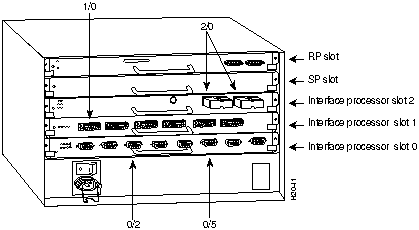
Interface slots are numbered 0 to 2 from the bottom slot up (in the orientation shown in Figure 15). The port numbers always begin at 0 and are numbered from left to right. The number of additional ports (1, 2, and so on) depends on the number of ports available on an interface. FDDI interfaces are always n/0, because each FIP supports one interface. Ethernet interfaces can be numbered from 0 through 5 because EIPs support up to six Ethernet ports.
You can identify interface ports by physically checking the slot/port location on the back of the router or by using software commands to display information about a specific interface or all interfaces in the router. To display information about every interface, use the show interfaces command (interfaces is plural) without variables. To display information about a specific interface, use the show interface command (interface is singular) with the interface type and port address in the format show interface [type slot/port]. If you abbreviate the command (sho int) and do not include variables, the system interprets the command as show interfaces and displays the status of all interfaces.
Following is an example of how the show interfaces command, used without variables, displays status information (including the physical slot and port address) for each interface in the router. In the following example, most of the status information for each interface is omitted.
Router# show int
Serial0/0 is up, line protocol is up
Hardware is cxBus Serial
Internet address is 131.108.123.4, subnet mask is 255.255.255.0
(display text omitted)
Ethernet1/2 is up, line protocol is up
Hardware is cxBus Ethernet, address is 0000.0c02.d0f1 (bia 0000.0c02.d0f1)
(display text omitted)
Fddi2/0 is administratively down, line protocol is down
Hardware is cxBus Fddi, address is 0000.0c02.adc2 (bia 0000.0c02.adc2)
Internet address is 131.108.31.4, subnet mask is 255.255.255.0
(display text omitted)
You can also use variables such as the interface type (Ethernet, Token Ring, FDDI, serial, or HSSI) and the port address (slot/port) to display information about a specific interface only. The following example shows the display for the first Ethernet port on an EIP in slot 1:
Router# show int ether 4/0
Ethernet1/0 is up, line protocol is up
Hardware is cxBus Ethernet, address is 0000.0c02.d0ce (bia 0000.0c02.d0ce)
Internet address is 131.108.31.7, subnet mask is 255.255.255.0
MTU 1500 bytes, BW 10000 Kbit, DLY 1000 usec, rely 255/255, load 1/255
Encapsulation ARPA, loopback not set, keepalive set (10 sec)
(display text omitted)
For complete command descriptions and instructions, refer to the related software documentation.
The following steps describe a basic configuration. Press the Return key after each configuration step unless otherwise noted.
Router# configure terminal Enter configuration commands, one per line. End with CNTL/Z. Router(config)#
Router(config)# interface ethernet 1/0
Router(config-int)# ip address 145.22.4.67 255.255.255.0
Router(config-int)# no shutdown
Router(config-int)# ^Z
Router# copy running-config startup-config [OK] Router#
Router# disable
Proceed to the following section to check the interface configuration with show commands.
After configuring the new interface, use the show commands to display the status of the new interface or all interfaces.
Following are descriptions and examples of the show commands. Descriptions are limited to fields that are relevant for verifying the configuration.
Router> show version GS Software (GS7), Version 9.17(3) Copyright (c) 1986-1993 by cisco Systems, Inc. Compiled Mon 11-Jan-93 14:44 System Bootstrap, Version 4.6(1) Current date and time is Fri 2-26-1993 2:18:52 Boot date and time is Fri 1-29-1993 11:42:38 Router uptime is 3 weeks, 6 days, 14 hours, 36 minutes System restarted by power-on Running default software Network configuration file is "Router", booted via tftp from 131.108.2.333 RP1 (68040) processor with 16384K bytes of memory. X.25 software, Version 2.0. Bridging software. 1 Switch Processor. 1 EIP controller (6 Ethernet). 1 TRIP controller (4 Token Ring). 6 Ethernet/IEEE 802.3 interface. 4 Token Ring/IEEE 802.5 interface. 1 HSSI network interface. 1 FDDI network interface. 128K bytes of non-volatile configuration memory. 4096K bytes of flash memory on embedded flash (in RP1). Configuration register is 0x0
Router> show int eth 4/1
Ethernet4/1 is administratively down, line protocol is down
Hardware is cxBus Ethernet, address is 0000.0c02.d0cd (bia 0000.0c02.d0cd)
MTU 1500 bytes, BW 10000 Kbit, DLY 1000 usec, rely 255/255, load 1/255
Encapsulation ARPA, loopback not set, keepalive set (10 sec)
ARP type: ARPA, ARP Timeout 4:00:00
Last input never, output never, output hang never
Last clearing of "show interface" counters never
Output queue 0/40, 0 drops; input queue 0/75, 0 drops
Five minute input rate 0 bits/sec, 0 packets/sec
Five minute output rate 0 bits/sec, 0 packets/sec
0 output errors, 0 collisions, 1 interface resets, 0 restarts
(display text omitted)
Router> show controller cbus
Switch Processor 5, hardware version 11.1, microcode version 1.2
512 Kbytes of main memory, 128 Kbytes cache memory
86 1520 byte buffers, 82 4484 byte buffers, 684 byte system buffer
Restarts: 0 line down, 0 hung output, 0 controller error
EIP 4, hardware version 5.1, microcode version 1.0
Interface 32 - Ethernet4/0, station addr 0000.0c02.d0cc (bia 0000.0c02.d0cc)
18 buffer RX queue threshold, 25 buffer TX queue limit, buffer size 1520
ift 0000, rql 18, tq 0000 0000, tql 25
Transmitter delay is 0 microseconds
Interface 33 - Ethernet4/1, station addr 0000.0c02.d0cd (bia 0000.0c02.d0cd)
18 buffer RX queue threshold, 25 buffer TX queue limit, buffer size 1520
ift 0000, rql 18, tq 0000 0000, tql 25
Transmitter delay is 0 microseconds
Interface 34 - Ethernet4/2, station addr 0000.0c02.d0ce (bia 0000.0c02.d0ce)
18 buffer RX queue threshold, 25 buffer TX queue limit, buffer size 1520
Transmitter delay is 0 microseconds
(display text omitted)
Router# show config Using 1652 out of 130048 bytes version 9.17 ! hostname Router ! enable-password guessagain ! microcode TRIP flash trip1-0 microcode reload ! (display text omitted) interface Ethernet4/0 ip address 131.108.216.14 255.255.255.0 ip route-cache cbus ! interface Ethernet4/1 no ip address shutdown ! (display text omitted)
Router> show protocols Global values: Internet Protocol routing is enabled Ethernet1/0 is up, line protocol is up (display text omitted)
The following summary describes how to use the show commands to verify that the new interfaces are configured correctly:
If the interface is down and you configured it as up, or if the displays indicate that the hardware is not functioning properly, ensure that the network interface is properly connected and terminated. If you still have problems bringing the interface up, contact a customer service representative for assistance.
This completes the configuration procedure for the new Ethernet interfaces.
The Cisco 7000 series and Cisco 75000 series routers support downloadable microcode, which enables you to upgrade microcode versions without having to physically replace the EPROMs on the boards. You can download new microcode versions and store multiple versions in Flash memory, and you can boot from them just as you can with the system software images. System software upgrades may also contain upgraded microcode images, which will load automatically when the new software image is loaded.
This section describes how to use and configure downloadable microcode and, if necessary, how to replace the microcode EPROM on the EIP.
You can download microcode to Flash memory by copying the TFTP image of a microcode version to Flash memory. When the microcode image is stored in Flash memory, you can use the microcode reload command to manually load the new microcode file, and the configure command to instruct the system to load the new image automatically at each system boot.
In order to compare the size of the microcode image and the amount of Flash memory available, you must know the size of the new microcode image. The image size is specified in the README file that is included on the floppy disk with the new image. Note the size of the new image before proceeding to ensure that you have sufficient available Flash memory for the new image.
![]()
Follow these steps to copy a microcode version from the TFTP server to Flash memory.
Router# show flash 4096K bytes of flash memory on embedded flash (in RP1). file offset length name 0 0xD134 55410 sp1-2 [4085336/4194304 bytes free]
buffer overflow - xxxx/xxxx
Router# copy tftp flash
IP address or name of remote host [255.255.255.255]? 131.108.12.106
Name of file to copy ? eip1-1
Copy eip1-1 from 131.108.12.106 into flash memory? [confirm]
Erase flash before writing? [confirm] no
Loading from 131.108.12.106: !!!!!!!!!!!!!!!!!!!!!!!!!!!!!!!!!!!!!!!!!!!!!!!!!!!! [OK - 108966/4194304 bytes] Verifying via checksum... Flash verification successful. Length = 53364, checksum = 0x0000
Router# show flash
4096K bytes of flash memory on embedded flash (in RP1).
file offset length name
0 0x40 55410 sp1-2
1 0xD0D4 53364 eip1-1
[4085336/4194304 bytes free]
Router# configure terminal Enter configuration commands, one per line. End with CNTL/Z. Router(config)#
Router(config)# microcode eip flash eip1-1
Router# copy running-config startup-config [OK] Router#
Router# configure Enter configuration commands, one per line. End with CNTL/Z. Router(config)# microcode reload
Router# show configuration
This completes the procedure for downloading microcode to Flash memory.
Ethernet connectors have either slide-type or jackscrew-type locks, both of which provide strain relief and secure the cable to the router port. The slide-type lock is most common, and it is standard on the EIP ports. If your Ethernet cables use thumbscrews instead of posts, you must replace the slide-type lock with jackscrews before you can connect the cables to the ports.
You need the following tools and parts to complete this replacement procedure. Because the holes in the EIP are threaded, you need only two lock washers and two jackscrews for each port. You do not need to install flat washers and hex nuts on the inside of the interface processor faceplate to secure the jackscrews. Discard the flat washers and hex nuts that are included in the kit.
If you are replacing the connector locks on an EIP that you have not yet installed in the chassis, skip this section. If the EIP is already installed in the interface processor slot and the Ethernet interfaces have been configured, you can avoid potential problems by administratively shutting down the interfaces and, when the replacement is complete, enabling the interface again. The following steps provide the commands for shutting down and enabling the interfaces.
The shutdown interface subcommand disables all functions and prevents all packet transmission on the interface that you specify with the interface type slot/port command. The no shutdown interface subcommand turns the interface back on. Because interface is a privileged-level configuration command, you might need a password to enable the privileged level of the EXEC command interpreter.
Follow these steps to shut down the Ethernet interfaces on the EIP:
Router# show interface ethernet slot/port
Router# configure terminal Enter configuration commands, one per line. End with CNTL/Z. Router(config)#
Router(config)# interface ethernet slot/port Router(config-int)# shutdown
The bracket for slide-type locks is secured to the EIP port with two small screws. You can complete this replacement procedure without removing the EIP from the chassis, but you should first shut down the interfaces you will work on. Following are the steps to remove slide-type locks from EIP ports:
Figure 16 Connector Slide-Lock Bracket

Use the hardware provided in the replacement kit to reinstall the connector. Do not use any of the hardware you removed from the slide-type lock bracket.
Figure 17 Jackscrew and Lock Washer Installation

Router# configure terminal Enter configuration commands, one per line. End with CNTL/Z. Router(config)# Router(config)# interface ethernet slot/port Router(config-int)# no shutdown Router(config-int)# interface ethernet slot/port Router(config-int)# no shutdown Router(config-int)# ^z Router# copy running-config startup-config [OK] Router#
This completes the connector lock replacement procedure. If you are installing a new EIP, return to "Installing an EIP" to continue with the installation. If you changed the cable locks on an EIP that was already installed and configured, proceed to the section "Checking the Configuration" on page 29, to verify the status of the interfaces.
Cisco Connection Online (CCO) is Cisco Systems' primary, real-time support channel. Maintenance customers and partners can self-register on CCO to obtain additional content and services.
Available 24 hours a day, 7 days a week, CCO provides a wealth of standard and value-added services to Cisco's customers and business partners. CCO services include product information, software updates, release notes, technical tips, the Bug Navigator, configuration notes, brochures, descriptions of service offerings, and download access to public and authorized files.
CCO serves a wide variety of users through two interfaces that are updated and enhanced simultaneously---a character-based version and a multimedia version that resides on the World Wide Web (WWW). The character-based CCO (called "CCO Classic") supports Zmodem, Kermit, Xmodem, FTP, Internet e-mail, and fax download options, and is excellent for quick access to information over lower bandwidths. The WWW version of CCO provides richly formatted documents with photographs, figures, graphics, and video, as well as hyperlinks to related information.
You can access CCO in the following ways:
http://www.cisco.com
.
cio.cisco.com
.
For a copy of CCO's Frequently Asked Questions (FAQ), contact
ciohelp@cisco.com.
For additional information, contact
cioteam@cisco.com.

tac@cisco.com.
To obtain general information about Cisco Systems, Cisco products, or upgrades, contact 800 553-6387, 408 526-7208, or
csrep@cisco.com.
|
|
Copyright 1988-1995 © Cisco Systems Inc.